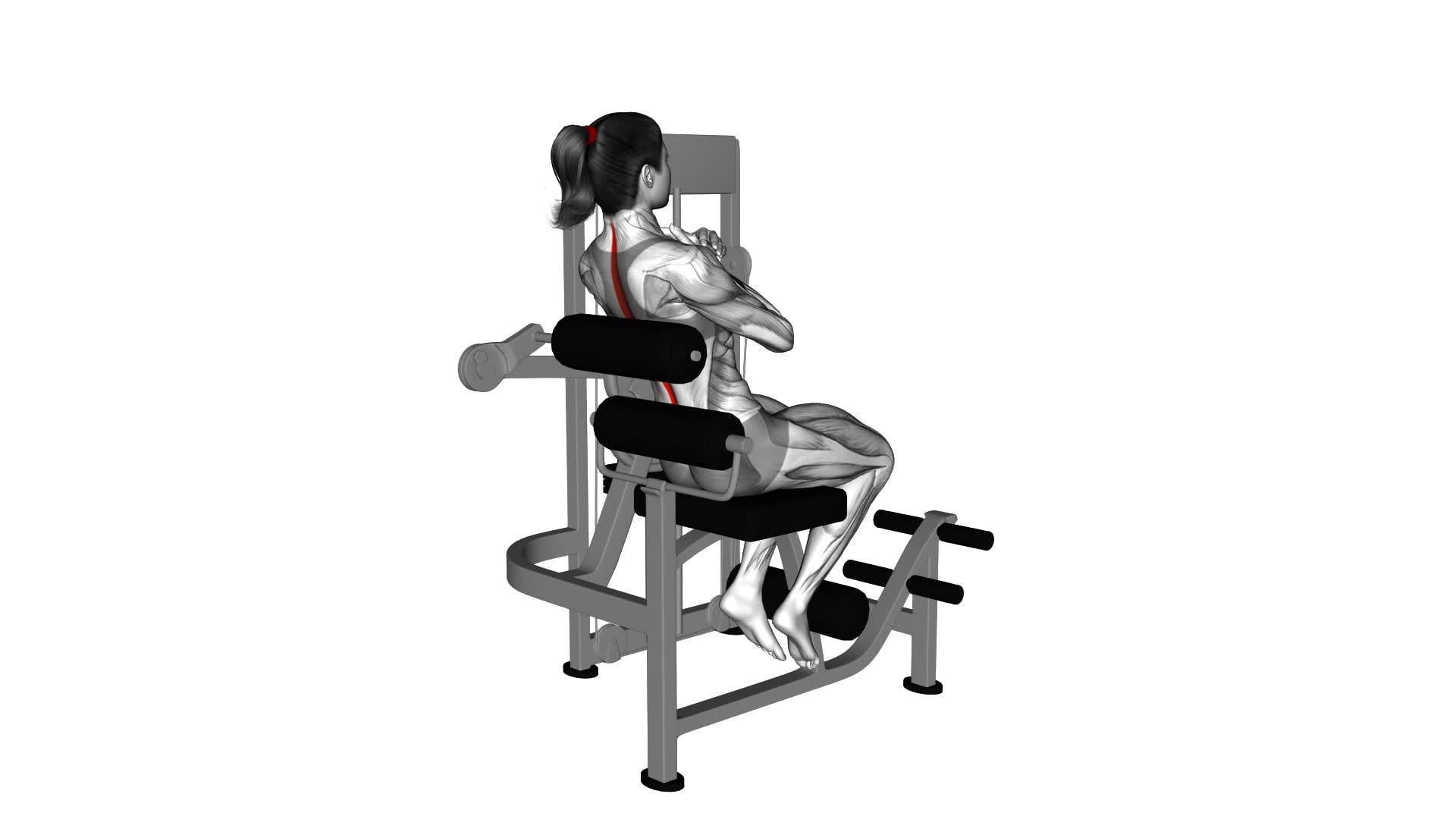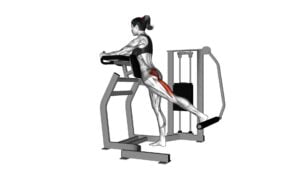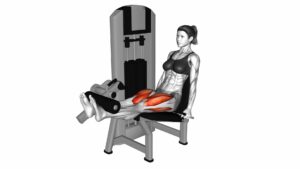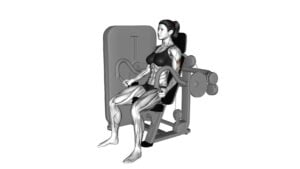Lever Back Extension (female) – Video Exercise Guide & Tips

Are you looking for a powerful exercise to strengthen your back? Look no further than the lever back extension.
Watch This Exercise Video
This video exercise guide will walk you through the proper form and technique, as well as variations and modifications.
Avoid common mistakes and learn how to incorporate this exercise into your workout routine.
Get ready to feel the burn and achieve a stronger, more resilient back.
Key Takeaways
- Lever back extension strengthens and tones back muscles.
- It improves overall posture and stability.
- It increases flexibility and range of motion in the back.
- Lever back extension alleviates back pain and reduces the risk of injury.
Benefits of Lever Back Extension for Women
The lever back extension exercise offers women numerous benefits for strengthening and toning their back muscles.
It's important to incorporate this exercise into your fitness routine to improve your overall posture and stability.
By targeting the muscles in your upper and lower back, the lever back extension helps to build strength and endurance.
This exercise also helps to improve flexibility, allowing for better range of motion in your back.
Additionally, the lever back extension can help to alleviate back pain and reduce the risk of injury by strengthening the muscles that support your spine.
By consistently performing this exercise, you'll notice improved posture, reduced back pain, and increased core strength.
It's crucial to prioritize the lever back extension in your workout routine to reap these benefits and achieve a strong and toned back.
Now, let's move on to discussing the proper form and technique for lever back extension to ensure you perform this exercise correctly and effectively.
Proper Form and Technique for Lever Back Extension
To perform the lever back extension exercise with proper form and technique, follow these steps:
- Position yourself on the lever back extension machine.
- Adjust the machine so that the foot pad is at the appropriate height for your body.
- Place your hips on the pad and hook your feet under the foot pad, ensuring that your heels are secure.
Next, execute the exercise:
- Cross your arms over your chest or place your hands behind your head.
- Take a deep breath in and engage your core muscles.
- Slowly lower your upper body towards the ground, keeping your back straight and your neck in a neutral position.
- Exhale as you lift your upper body back up to the starting position.
Remember these additional tips:
- Maintain control throughout the movement and avoid using momentum to lift yourself up.
- Focus on squeezing your glutes and using your lower back muscles to perform the exercise.
Proper form and technique are essential to maximize the benefits of the lever back extension. By maintaining a neutral spine and engaging the correct muscles, you can strengthen your lower back and improve your posture. The lever back extension exercise can also help to increase overall core stability and prevent lower back pain.
In the next section, we'll explore variations and modifications for the lever back extension exercise to cater to different fitness levels and goals.
Variations and Modifications for Lever Back Extension
Now let's explore some variations and modifications you can try for the lever back extension exercise. This exercise can be modified to suit your individual needs and goals.
One variation you can try is the single-leg lever back extension. Instead of using both legs, you can lift one leg off the ground and perform the exercise with just one leg at a time. This variation adds an extra challenge to your core and glute muscles.
Another modification you can make is to use resistance bands or weights. By adding resistance, you can increase the intensity of the exercise and target your muscles even more effectively. You can attach a resistance band to your ankles or hold a dumbbell between your feet. This will provide additional resistance as you perform the back extension.
If you find the lever back extension too challenging, you can also perform the exercise on an incline bench. By adjusting the angle of the bench, you can decrease the difficulty and still reap the benefits of the exercise. This modification is great for beginners or anyone with lower back issues.
Remember to always listen to your body and choose the variation or modification that feels right for you. By incorporating these variations and modifications into your workout routine, you can continue to challenge yourself and make progress towards your fitness goals.
Common Mistakes to Avoid During Lever Back Extension
To avoid common mistakes during lever back extension, focus on maintaining proper form and engaging your core and glute muscles. Here are three common mistakes to avoid and tips to ensure you perform the exercise correctly:
- Arching your back excessively: One of the most common mistakes is arching your back too much during the movement. This can strain your lower back and take the focus away from your glutes. To avoid this, imagine tucking your tailbone and engaging your core. Keep your back straight throughout the exercise.
- Using momentum: Another mistake is relying on momentum to lift your legs. This reduces the effectiveness of the exercise and increases the risk of injury. Instead, focus on using your glute muscles to lift your legs and maintain control throughout the movement. Keep the movement slow and controlled.
- Neglecting your core and glutes: The lever back extension primarily targets your core and glutes. Failing to engage these muscles properly can lead to poor form and decreased effectiveness. Before starting the exercise, consciously activate your core and glute muscles. Maintain this engagement throughout the entire movement.
Tips for Incorporating Lever Back Extension Into Your Workout Routine
To incorporate lever back extension into your workout routine effectively, consider the following tips.
First, if you're looking to incorporate lever back extension into cardio workouts, try performing the exercise towards the end of your cardio session. This will ensure that your muscles are warmed up and ready for the movement.
Additionally, using resistance bands for lever back extension can increase the intensity of the exercise. Attach the resistance band around a sturdy object and hold the handles with your hands. As you perform the exercise, the resistance from the band will challenge your muscles even further.
Remember to maintain proper form throughout the exercise by keeping your core engaged and your back straight.
It's also important to start with a weight or resistance level that's appropriate for your fitness level. Gradually increase the weight or resistance as you become stronger and more comfortable with the exercise.
Lastly, listen to your body and take breaks as needed to prevent overexertion or injury.
Frequently Asked Questions
How Many Repetitions Should I Do for Lever Back Extension?
To determine the optimal technique for lever back extension and the number of repetitions, it's important to consider your fitness goals and current fitness level.
Lever back extension is a great exercise for strengthening your lower back muscles and improving posture. By incorporating this exercise into your workout routine, you can enhance core stability and reduce the risk of lower back pain.
Consulting with a fitness professional can help you determine the appropriate number of repetitions for your specific needs.
Can Lever Back Extension Help Improve Posture?
Lever back extensions can indeed help improve your posture. Regular practice of this exercise has many benefits, such as strengthening your back muscles and promoting proper alignment of your spine.
To achieve the best results, it's crucial to focus on correct form and technique. Keep your core engaged, maintain a neutral spine, and avoid arching your back excessively.
Is It Safe to Perform Lever Back Extension if I Have Lower Back Pain?
If you have lower back pain, it may not be safe to perform lever back extensions. Instead, try alternative exercises for lower back pain relief, such as gentle stretches or exercises that target the core and hips.
It's important to take precautions when performing lever back extensions with lower back pain, such as using proper form, starting with light weights, and stopping if you feel any discomfort.
Always consult with a healthcare professional before starting any new exercise program.
How Long Will It Take to See Results From Lever Back Extension?
To see results from lever back extension, it's important to be consistent with your workouts. By regularly incorporating this exercise into your routine, you can improve flexibility and prevent lower back injuries.
The time it takes to see results will vary depending on factors such as your current fitness level and how often you perform the exercise. Stay committed and you'll start noticing improvements in no time.
Keep up the hard work!
What Other Exercises Can I Combine With Lever Back Extension for a Full Body Workout?
To get a full body workout, you can combine lever back extension with core exercises and upper body exercises.
Core exercises like planks and Russian twists will engage your abdominal muscles and strengthen your core.
For your upper body, try exercises like push-ups or dumbbell rows to work your chest, arms, and back.
Conclusion
In conclusion, the lever back extension is a beneficial exercise for women that targets the muscles in the back and improves overall strength and posture.
By maintaining proper form and technique, variations and modifications can be made to suit individual fitness levels and goals.
Avoiding common mistakes is crucial to prevent injury and maximize the effectiveness of this exercise.
Incorporating the lever back extension into your workout routine can help you achieve a strong and toned back.

Author
Years ago, the spark of my life’s passion ignited in my mind the moment I stepped into the local gym for the first time. The inaugural bead of perspiration, the initial endeavor, the very first surge of endorphins, and a sense of pride that washed over me post-workout marked the beginning of my deep-seated interest in strength sports, fitness, and sports nutrition. This very curiosity blossomed rapidly into a profound fascination, propelling me to earn a Master’s degree in Physical Education from the Academy of Physical Education in Krakow, followed by a Sports Manager diploma from the Jagiellonian University. My journey of growth led me to gain more specialized qualifications, such as being a certified personal trainer with a focus on sports dietetics, a lifeguard, and an instructor for wellness and corrective gymnastics. Theoretical knowledge paired seamlessly with practical experience, reinforcing my belief that the transformation of individuals under my guidance was also a reflection of my personal growth. This belief holds true even today. Each day, I strive to push the boundaries and explore new realms. These realms gently elevate me to greater heights. The unique combination of passion for my field and the continuous quest for growth fuels my drive to break new ground.







